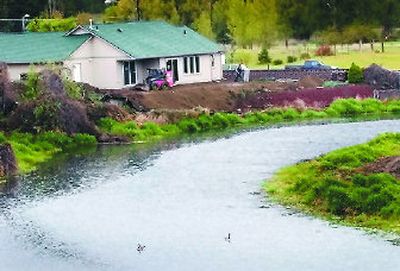Stream cleanups planned

Plans to increase stream flows and reduce pollution in Latah Creek and the Little Spokane River are being devised by the state Department of Ecology in conjunction with the Spokane County Conservation District and others.
The goal is not only to improve the health of the two waterways but also to improve stream quality of the Spokane River and Lake Spokane.
Water samples from throughout the Latah Creek drainage have been submitted to the Ecology Department, which is establishing pollution limits for the creek.
Public hearings on maximum pollution levels are expected later this year, said Rick Noll of the conservation district. The meetings will get the public involved in what can be done to improve the health of the creek, which flows through southern Spokane County.
Work on setting standards for the Little Spokane River is behind schedule but could be completed by next year, Noll said.
The standards will set pollution limits for fecal coliform bacteria, water temperature, sediment and phosphates.
Municipal and industrial users of the Spokane River have agreed to help finance some water-improvement projects on the two creeks as part of a larger program to clean up the Spokane River. The city of Spokane is planning nearly $500 million in improvements to the region’s largest wastewater plant, including high-tech phosphorus removal.
Reducing phosphorus coming from Latah Creek and the Little Spokane could help the larger dischargers meet the state’s stringent pollution standards for phosphorus, Noll said.
Part of the work on Latah Creek and the Little Spokane is to determine where phosphorus is coming from. Some scientists suspect that soil erosion is a significant source of the pollutant. Livestock also are a contributor.
Soil flowing off agricultural land into Latah Creek is considered a major source of sediment that has filled the basin behind Nine Mile Falls Dam and may be a source of phosphorus.
“There is no reason why we can’t have agriculture and a productive, healthy stream,” said Walt Edelen of the conservation district. “It just takes time and cooperation.”
For years, the conservation district has promoted measures to get livestock away from creeks and other bodies of water and to get landowners to plant native vegetation along streams.
In addition, the district is working to encourage farmers to use a new generation of no-till seeding technology, which promises to reduce soil erosion and save on tractor fuel, Edelen said.
The district also is trying to get water users to stop pumping from Latah Creek, and it may be able to purchase water rights from some of them.
Recently, the town of Tekoa sank a municipal well to supply a golf course in the area. The golf course had been using stream water for irrigation, Noll said.
The conservation district also has negotiated to have a stream gauge installed at the Idaho state line so officials can keep track of how much water is flowing into Washington. During the summer, Latah Creek flows so slowly that only 5 to 10 cubic feet of water per second are measured at a stream gauge near its mouth.
The conservation district also has been working with Spokane County to replace a culvert on Chapman Road, which crosses a tributary of Latah Creek. The culvert prevents native fish, including red-band trout, from moving up and down the stream.
Work to improve water quality in the two streams could take 10 or 15 years to accomplish, the two conservation staffers said.
“This is not a two-year fix,” Noll said.